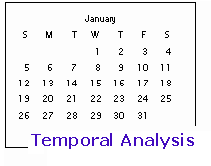

Larsen's method can detect temporal clustering in single and several time series with group-level data. Larsen's test statistic K is sensitive to a unimodal clustering of occupied cells.
The normality assumption used to evaluate significance does not hold when the time series is shorter than 10 intervals. When you use Larsen's method to analyze time series with fewer than 10 intervals, the method will not be very powerful. For short time series consider using smaller time intervals or perhaps collecting data from additional time periods. As alternatives consider the Empty Cells test, or Dat's 0-1 matrix test when cases are numerous.
Larsen's method also requires two or more of the time intervals to have cases. Time series with fewer than 2 occupied intervals are excluded from an analysis. Each time series must have at least 1 unoccupied cell.
You cannot use Larsen's method with rates. Counts are required and the method is biased by changes in population size through time.
Example
Larsen et al. (1973) used the method for simultaneous clustering in several time series to screen for clusters of cases of children with acute leukemia in 18 census tracts in Atlanta, Georgia. Attention was brought to these data because the leukemia within census tracts appeared to cluster. Upon further scrutiny, single leukemia clusters were identified in 10 of the tracts. The data showed significant unimodal clustering when all of the census tracts were considered simultaneously.